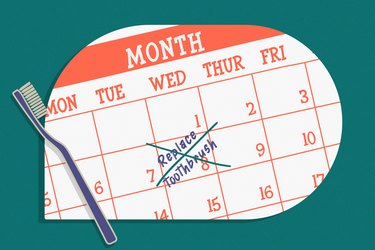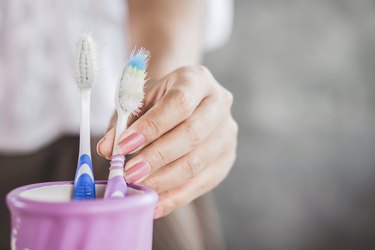
Like razors, running shoes and kitchen sponges, you're supposed to swap out your toothbrush on a regular basis — every three to four months (or sooner, if the bristles are visibly worn or frayed), according to the American Dental Association (ADA).
But if your brush looks like it's in decent shape — or if you have an electric toothbrush with pricey replacement heads — is it OK to hang onto it for longer, or are you jeopardizing your dental health? Here's what the pros say.
Video of the Day
Video of the Day
New Toothbrushes Work Better Than Old Ones
"The difference between new and worn toothbrushes seems to come down to the stiffness, sharpness and straightness of the individual bristles," says Timothy Iafolla, DMD, MPH, chief of the Program Analysis and Reporting Branch at the National Institute of Dental and Craniofacial Research. "Research indicates that worn toothbrushes with bristles that are splayed apart or blunted are less effective at plaque removal and prevention of gingival recession than new toothbrushes."
In other words: An old toothbrush just doesn't clean your teeth as well, and it may even be bad news for your gums.
This holds true whether you have a manual or electric brush.
Want to check out the contrast for yourself? This video from Applied Science compares the appearance of new versus used brushes. Under a microscope, you can see that the bristles on the old brush are dull and rounded, thanks in part to the abrasive quality of toothpaste.
Here’s What Can Happen if You Use a Toothbrush Past Its Prime
Here's the long answer on why you should replace your toothbrush every three months:
1. Your Tooth and Gum Health May Suffer
Brushing prevents gum disease by getting rid of plaque that forms around the gum line.
"If plaque deposits are not regularly disrupted, they can absorb minerals from saliva and form a hard substance called calculus (tartar), which cannot be removed using a brush or dental floss," Dr. Iafolla says. "The chronic inflammation caused by calculus deposits at or below the gum line is what leads to periodontal disease."
Now here's where your toothbrush comes into play. "A visibly worn brush is less effective at removing plaque, especially below the gum line," Dr. Iafolla says. What's more, frayed bristles can irritate your gum tissue and lead to gum sensitivity or recession.
Lingering plaque opens the door to a number of oral health complications, including decay, gingivitis and eventually gum disease.
2. Ancient Brushes Are a Hotbed of Bacteria
The older your brush, the more germs it harbors. A small August 2015 study in the Journal of Natural Science, Biology and Medicine determined that three-month-old toothbrushes had heavy bacterial contamination (including fecal matter, gross!) compared to brushes that had been used for just one month.
Before you freak, though: The ADA says "there is no evidence that these bacteria cause adverse health effects."
How Old Is Too Old?
When it comes to toothbrushes, age is just a number. The recommendation to replace your brush after three to four months is a ballpark, but the condition of your brush is more important than precisely how long you've been using it for.
"Toothbrush wear depends on user habits, such as frequency and duration of use, brushing force and brushing technique," Dr. Iafolla says, pointing to a November 2013 clinical study in the International Journal of Dental Hygiene, which looked at various levels of toothbrush wear after three months of use.
"The study showed that brushes that are visibly more worn are less effective at removing plaque than brushes that appeared less worn, while brushes with very little visible wear are almost as effective as new brushes," Dr. Iafolla says. "From this and other studies, it seems as though the age of the toothbrush is not as important to plaque removal as the wear of the bristles, especially when they become visibly bent and splayed."
What’s the Deal With Color-Changing Bristles?
Some toothbrushes have dyed bristles to remind users when to swap them out. Once the bristles fade, it's time to get a new brush.
Although this can be a helpful visual, the biggest indicator for replacing a toothbrush will always be the state of the bristles. If the color is still vibrant, but the bristles are worn down, it is time to change your brush, the ADA says.
Also, keep in mind that not all brightly hued bristles reflect wear and tear, so be sure to read the label.
The Red Flag You Should Always Pay Attention To

What does it mean if your brush starts looking shabby before the three-month mark? First, make sure you are purchasing a toothbrush with the ADA seal. The ADA confirms that these brushes are tested to ensure the bristles won't fall out with normal use.
If your brush has the ADA's stamp of approval, then excessive wear early on could be a sign you're using too much force to clean your chiclets. According to the ADA, many people brush their teeth too vigorously, which can cause irritation, bleeding and injury to the gums — potentially resulting in infection, recession and gum trauma. Brushing too hard can also cause enamel to wear down faster, which is irreversible once the damage is done.
"It is not necessary to use a lot of pressure when brushing," Dr. Iafolla says. "Direct the tips of the bristles at a 45-degree-angle into the gum line and brush using a gentle, circular movement; then flick the toothbrush along the tooth away from the gum line."
Next, gently move the brush back and forth in short (tooth-wide) strokes. To clean the inside surfaces of the front teeth, tilt the brush vertically and make several up-and-down strokes. Finally, brush the chewing surfaces of the teeth. Do this for 2 minutes twice a day.
Bonus: Easing up on the pressure will also extend the life of your toothbrush.
6 Features That Actually Matter in a Toothbrush
From sensors to antibacterial light therapy to smartphone connectivity, the toothbrush marketplace is flooded with new-fangled accessories. Here's how to sift through all the bells and whistles so you can find a brush with the qualities that truly improve your dental health.
1. Soft Bristles
The ADA highly recommends soft bristles over medium and hard bristles, because they will still clean your teeth excellently without damaging your enamel or gums.
An older 2011 study in Oral Health & Preventative Dentistry found that although medium bristles scraped off more plaque than their softer counterparts, they also created more microtears along the gums.
What's more, the ADA notes that hard bristles exacerbate the common mistake of brushing too aggressively.
2. Bristles With Round Ends
A March 2016 study in Brazilian Oral Research suggests that toothbrushes with rounded tips pulverize plaque better than those with tapered or pointed tips.
3. Angled Bristles
A June 2012 review in the International Journal of Dental Hygiene compared toothbrushes with a variety of bristle shapes: flat and straight across, multilevel (with some bristles positioned higher than others) and angled (where certain bristles are slanted). Brushes with angled bristles removed the most plaque.
4. A Compact Brush Head
"It is recommended that every surface of every tooth be brushed, and a brush with a small head may make it easier to accomplish that objective," Dr. Iafolla says.
If your brush head is too large, you might not be able to reach all areas of your mouth with ease, which means you're not getting a proper clean.
5. An Electric Toothbrush
It turns out a battery-operated brush may be worth the investment. A systematic review and meta-analysis in the February 2020 issue of the International Journal of Dental Hygiene confirmed that an electric toothbrush clears away more plaque than an old-school brush.
How much better is it? A June 2014 Cochrane review found that, after three months of use, electric toothbrushes removed 21 percent more plaque than manual toothbrushes and led to an 11 percent decline in gingivitis.
Meanwhile, a May 2019 study in the Journal of Clinical Periodontology concluded that people using powered toothbrushes had healthier gums, experienced less progression of gum disease and kept 20 percent more teeth than people using regular brushes.
"Also, people who have reduced dexterity, including children or those with a disability or condition that makes brushing difficult, may find an electric toothbrush makes effective brushing easier," Dr. Iafolla says.
For example, if you have arthritis and it's tricky to grip a toothbrush, an electric version will do most of the heavy lifting for you.
That said, you can still do a solid job without shelling out for a tech-savvy model.
"With the correct brushing technique, both manual and powered toothbrushes have been shown in clinical studies to be effective at removing plaque," Dr. Iafolla says.
6. The ADA Seal
Ultimately, the ADA stresses that there's no one-size-fits-all toothbrush; the best style for you is simply the one that allows you to easily brush your teeth well.
But whichever brush you choose, make sure it has earned the ADA Seal of Acceptance. The ADA says that in order to earn the Seal, a brush must have studies that back up its safety and efficacy. It's basically a guarantee that the brush will work well.
So, How Bad Is It Really to Use the Same Toothbrush Forever?
Although you might be able to safely stretch the lifespan of your brush slightly beyond the three- to four-month mark if the bristles don't appear worn, the best practice is to replace it within that timeframe.
And if you've had the same brush "forever" — meaning, you can't even remember the last time you got a new one — the experts agree that you are definitely pushing your dental hygiene luck. It's time to head to the store and put your money where your mouth is!
- Brazilian Oral Health: "Combined effect of end-rounded versus tapered bristles and a dentifrice on plaque removal and gingival abrasion"
- Oral Health & Preventative Dentistry: "Biofilm removal and gingival abrasion with medium and soft toothbrushes"
- International Journal of Dental Hygiene: "The efficacy of manual toothbrushes following a brushing exercise: a systematic review"
- International Journal of Dental Hygiene: "How effective is a powered toothbrush as compared to a manual toothbrush? A systematic review and meta-analysis of single brushing exercises"
- Cochrane: "Powered/electric toothbrushes compared to manual toothbrushes for maintaining oral health"
- Journal of Clinical Periodontology: "Long‐term impact of powered toothbrush on oral health: 11‐year cohort study"
- Journal of Natural Science, Biology and Medicine: "Assessment of microbial contamination on twice a day used toothbrush head after 1-month and 3 months: An in vitro study"
- ADA: " Oral Health Topics: Toothbrushes"
- ADA: "Seal of Acceptance FAQ"
Is this an emergency? If you are experiencing serious medical symptoms, please see the National Library of Medicine’s list of signs you need emergency medical attention or call 911.
